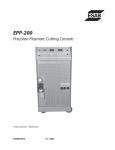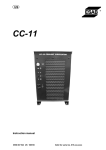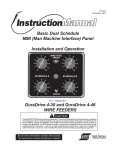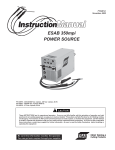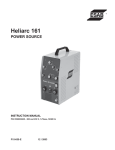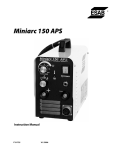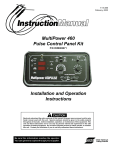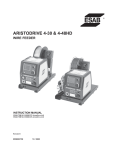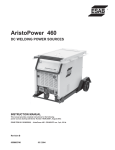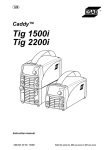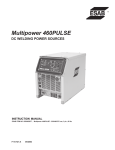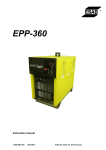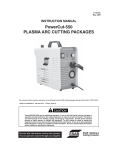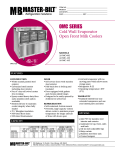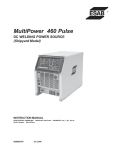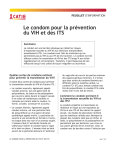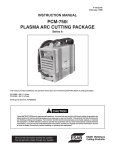Download F15-140_WC-9 _coolant_circulator_nov03.PMD
Transcript
WC-9 Coolant Circulator Instruction Manual F15-140-B 11 / 2003 Vaild serial no. WxxJ348xxx and above BE SURE THIS INFORMATION REACHES THE OPERATOR. YOU CAN GET EXTRA COPIES THROUGH YOUR SUPPLIER. These INSTRUCTIONS are for experienced operators. If you are not fully familiar with the principles of operation and safe practices for arc welding and cutting equipment, we urge you to read our booklet, "Precautions and Safe Practices for Arc Welding, Cutting, and Gouging," Form 52-529. Do NOT permit untrained persons to install, operate, or maintain this equipment. Do NOT attempt to install or operate this equipment until you have read and fully understand these instructions. If you do not fully understand these instructions, contact your supplier for further information. Be sure to read the Safety Precautions before installing or operating this equipment. USER RESPONSIBILITY This equipment will perform in conformity with the description thereof contained in this manual and accompanying labels and/or inserts when installed, operated, maintained and repaired in accordance with the instructions provided. This equipment must be checked periodically. Malfunctioning or poorly maintained equipment should not be used. Parts that are broken, missing, worn, distorted or contaminated should be replaced immediately. Should such repair or replacement become necessary, the manufacturer recommends that a telephone or written request for service advice be made to the Authorized Distributor from whom it was purchased. This equipment or any of its parts should not be altered without the prior written approval of the manufacturer. The user of this equipment shall have the sole responsibility for any malfunction which results from improper use, faulty maintenance, damage, improper repair or alteration by anyone other than the manufacturer or a service facility designated by the manufacturer. TABLE OF CONTENTS SECTION PARAGRAPH TITLE PAGE SECTION 1 SAFETY ......................................................................................................................... 4 English ........................................................................................................................... 5 Spanish .......................................................................................................................... 6 French ........................................................................................................................... 9 SECTION 2 2.0 2.1 DESCRIPTION ............................................................................................................ 11 Description ................................................................................................................... 11 Specifications ............................................................................................................... 11 SECTION 3 3.0 INSTALLATION ........................................................................................................... 13 Installation ..................................................................................................................... 13 SECTION 4 4.0 MAINTENANCE ........................................................................................................... 15 Maintenance ................................................................................................................. 15 SECTION 5 5.0 5.1 5.2 TROUBLESHOOTING ............................................................................................... 17 Troubleshooting ............................................................................................................ 17 Troubleshooting Diagrams ........................................................................................... 18 Testing Procedures ...................................................................................................... 19 SECTION 6 6.0 REPLACEMENT PARTS ............................................................................................ 21 Replacement Parts ....................................................................................................... 21 3 TABLE OF CONTENTS 4 SECTION 1 SAFETY PRECAUTIONS 5. Do not use equipment beyond its ratings. For example, overloaded welding cable can overheat and create a fire hazard. 6. After completing operations, inspect the work area to make certain there are no hot sparks or hot metal which could cause a later fire. Use fire watchers when necessary. 7. For additional information, refer to NFPA Standard 51B, "Fire Prevention in Use of Cutting and Welding Processes", available from the National Fire Protection Association, Batterymarch Park, Quincy, MA 02269. WARNING: These Safety Precautions are for your protection. They summarize precautionary information from the references listed in Additional Safety Information section. Before performing any installation or operating procedures, be sure to read and follow the safety precautions listed below as well as all other manuals, material safety data sheets, labels, etc. Failure to observe Safety Precautions can result in injury or death. PROTECT YOURSELF AND OTHERS -Some welding, cutting, and gouging processes are noisy and require ear protection. The arc, like the sun, emits ultraviolet (UV) and other radiation and can injure skin and eyes. Hot metal can cause burns. Training in the proper use of the processes and equipment is essential to prevent accidents. Therefore: ELECTRICAL SHOCK -- Contact with live electrical parts and ground can cause severe injury or death. DO NOT use AC welding current in damp areas, if movement is confined, or if there is danger of falling. 1. Always wear safety glasses with side shields in any work area, even if welding helmets, face shields, and goggles are also required. 2. Use a face shield fitted with the correct filter and cover plates to protect your eyes, face, neck, and ears from sparks and rays of the arc when operating or observing operations. Warn bystanders not to watch the arc and not to expose themselves to the rays of the electric-arc or hot metal. 3. Wear flameproof gauntlet type gloves, heavy long-sleeve shirt, cuffless trousers, high-topped shoes, and a welding helmet or cap for hair protection, to protect against arc rays and hot sparks or hot metal. A flameproof apron may also be desirable as protection against radiated heat and sparks. 4. Hot sparks or metal can lodge in rolled up sleeves, trouser cuffs, or pockets. Sleeves and collars should be kept buttoned, and open pockets eliminated from the front of clothing 5. Protect other personnel from arc rays and hot sparks with a suitable non-flammable partition or curtains. 6. Use goggles over safety glasses when chipping slag or grinding. Chipped slag may be hot and can fly far. Bystanders should also wear goggles over safety glasses. 1. Be sure the power source frame (chassis) is connected to the ground system of the input power. 2. Connect the workpiece to a good electrical ground. 3. Connect the work cable to the workpiece. A poor or missing connection can expose you or others to a fatal shock. 4. Use well-maintained equipment. Replace worn or damaged cables. 5. Keep everything dry, including clothing, work area, cables, torch/electrode holder, and power source. 6. Make sure that all parts of your body are insulated from work and from ground. 7. Do not stand directly on metal or the earth while working in tight quarters or a damp area; stand on dry boards or an insulating platform and wear rubber-soled shoes. 8. Put on dry, hole-free gloves before turning on the power. 9. Turn off the power before removing your gloves. 10. Refer to ANSI/ASC Standard Z49.1 (listed on next page) for specific grounding recommendations. Do not mistake the work lead for a ground cable. ELECTRIC AND MAGNETIC FIELDS — May be dangerous. Electric current flowing through any conductor causes localized Electric and Magnetic Fields (EMF). Welding and cutting current creates EMF around welding cables and welding machines. Therefore: FIRES AND EXPLOSIONS -- Heat from flames and arcs can start fires. Hot slag or sparks can also cause fires and explosions. Therefore: 1. Remove all combustible materials well away from the work area or cover the materials with a protective nonflammable covering. Combustible materials include wood, cloth, sawdust, liquid and gas fuels, solvents, paints and coatings, paper, etc. 2. Hot sparks or hot metal can fall through cracks or crevices in floors or wall openings and cause a hidden smoldering fire or fires on the floor below. Make certain that such openings are protected from hot sparks and metal.“ 3. Do not weld, cut or perform other hot work until the workpiece has been completely cleaned so that there are no substances on the workpiece which might produce flammable or toxic vapors. Do not do hot work on closed containers. They may explode. 4. Have fire extinguishing equipment handy for instant use, such as a garden hose, water pail, sand bucket, or portable fire extinguisher. Be sure you are trained in its use. 1. Welders having pacemakers should consult their physician before welding. EMF may interfere with some pacemakers. 2. Exposure to EMF may have other health effects which are unknown. 3. Welders should use the following procedures to minimize exposure to EMF: A. Route the electrode and work cables together. Secure them with tape when possible. B. Never coil the torch or work cable around your body. C. Do not place your body between the torch and work cables. Route cables on the same side of your body. D. Connect the work cable to the workpiece as close as possible to the area being welded. E. Keep welding power source and cables as far away from your body as possible. 5 10/2001 SECTION 1 SAFETY PRECAUTIONS EQUIPMENT MAINTENANCE -- Faulty or improperly maintained equipment can cause injury or death. Therefore: FUMES AND GASES -- Fumes and gases, can cause discomfort or harm, particularly in confined spaces. Do not breathe fumes and gases. Shielding gases can cause asphyxiation. Therefore: 1. Always have qualified personnel perform the installation, troubleshooting, and maintenance work. Do not perform any electrical work unless you are qualified to perform such work. 2. Before performing any maintenance work inside a power source, disconnect the power source from the incoming electrical power. 3. Maintain cables, grounding wire, connections, power cord, and power supply in safe working order. Do not operate any equipment in faulty condition. 4. Do not abuse any equipment or accessories. Keep equipment away from heat sources such as furnaces, wet conditions such as water puddles, oil or grease, corrosive atmospheres and inclement weather. 5. Keep all safety devices and cabinet covers in position and in good repair. 6. Use equipment only for its intended purpose. Do not modify it in any manner. 1. Always provide adequate ventilation in the work area by natural or mechanical means. Do not weld, cut, or gouge on materials such as galvanized steel, stainless steel, copper, zinc, lead, beryllium, or cadmium unless positive mechanical ventilation is provided. Do not breathe fumes from these materials. 2. Do not operate near degreasing and spraying operations. The heat or arc rays can react with chlorinated hydrocarbon vapors to form phosgene, a highly toxic gas, and other irritant gases. 3. If you develop momentary eye, nose, or throat irritation while operating, this is an indication that ventilation is not adequate. Stop work and take necessary steps to improve ventilation in the work area. Do not continue to operate if physical discomfort persists. 4. Refer to ANSI/ASC Standard Z49.1 (see listing below) for specific ventilation recommendations. 5. WARNING: This product, when used for welding or cutting, produces fumes or gases which contain chemicals known to the State of California to cause birth defects and, in some cases, cancer. (California Health & Safety Code §25249.5 et seq.) ADDITIONAL SAFETY INFORMATION -- For more information on safe practices for electric arc welding and cutting equipment, ask your supplier for a copy of "Precautions and Safe Practices for Arc Welding, Cutting and Gouging", Form 52-529. The following publications, which are available from the American Welding Society, 550 N.W. LeJuene Road, Miami, FL 33126, are recommended to you: 1. ANSI/ASC Z49.1 - "Safety in Welding and Cutting" 2. AWS C5.1 - "Recommended Practices for Plasma Arc Welding" 3. AWS C5.2 - "Recommended Practices for Plasma Arc Cutting" 4. AWS C5.3 - "Recommended Practices for Air Carbon Arc Gouging and Cutting" 5. AWS C5.5 - "Recommended Practices for Gas Tungsten Arc Welding“ 6. AWS C5.6 - "Recommended Practices for Gas Metal Arc Welding"“ 7. AWS SP - "Safe Practices" - Reprint, Welding Handbook. 8. ANSI/AWS F4.1, "Recommended Safe Practices for Welding and Cutting of Containers That Have Held Hazardous Substances." CYLINDER HANDLING -- Cylinders, if mishandled, can rupture and violently release gas. Sudden rupture of cylinder, valve, or relief device can injure or kill. Therefore: 1. Use the proper gas for the process and use the proper pressure reducing regulator designed to operate from the compressed gas cylinder. Do not use adaptors. Maintain hoses and fittings in good condition. Follow manufacturer's operating instructions for mounting regulator to a compressed gas cylinder. 2. Always secure cylinders in an upright position by chain or strap to suitable hand trucks, undercarriages, benches, walls, post, or racks. Never secure cylinders to work tables or fixtures where they may become part of an electrical circuit. 3. When not in use, keep cylinder valves closed. Have valve protection cap in place if regulator is not connected. Secure and move cylinders by using suitable hand trucks. Avoid rough handling of cylinders. 4. Locate cylinders away from heat, sparks, and flames. Never strike an arc on a cylinder. 5. For additional information, refer to CGA Standard P-1, "Precautions for Safe Handling of Compressed Gases in Cylinders", which is available from Compressed Gas Association, 1235 Jefferson Davis Highway, Arlington, VA 22202. MEANING OF SYMBOLS - As used throughout this manual: Means Attention! Be Alert! Your safety is involved. Means immediate hazards which, if not avoided, will result in immediate, serious personal injury or loss of life. Means potential hazards which could result in personal injury or loss of life. Means hazards which could result in minor personal injury. 6 SECTION 1 PRECAUCION DE SEGURIDAD pueden ocasionar un fuego. 6. Después de termirar la operación del equipo, inspeccione el área de trabajo para cerciorarse de que las chispas o metal caliente ocasionen un fuego más tarde. Tenga personal asignado para vigilar si es necesario. 7. Para información adicional , haga referencia a la publicación NFPA Standard 51B, "Fire Prevention in Use of Cutting and Welding Processes", disponible a través de la National Fire Protection Association, Batterymarch Park, Quincy, MA 02269. ADVERTENCIA: Estas Precauciones de Seguridad son para su protección. Ellas hacen resumen de información proveniente de las referencias listadas en la sección "Información Adicional Sobre La Seguridad". Antes de hacer cualquier instalación o procedimiento de operación , asegúrese de leer y seguir las precauciones de seguridad listadas a continuación así como también todo manual, hoja de datos de seguridad del material, calcomanias, etc. El no observar las Precauciones de Seguridad puede resultar en daño a la persona o muerte. CHOQUE ELECTRICO -- El contacto con las partes eléctricas energizadas y tierra puede causar daño severo o muerte. NO use soldadura de corriente alterna (AC) en áreas húmedas, de movimiento confinado en lugares estrechos o si hay posibilidad de caer al suelo. PROTEJASE USTED Y A LOS DEMAS-Algunos procesos de soldadura, corte y ranurado son ruidosos y requiren protección para los oídos. El arco, como el sol , emite rayos ultravioleta (UV) y otras radiaciones que pueden dañar la piel y los ojos. El metal caliente causa quemaduras. EL entrenamiento en el uso propio de los equipos y sus procesos es esencial para prevenir accidentes. Por lo tanto: 1. Utilice gafas de seguridad con protección a los lados siempre 2. 3. 4. 5. 6. 2. 3. que esté en el área de trabajo, aún cuando esté usando careta de soldar, protector para su cara u otro tipo de protección. Use una careta que tenga el filtro correcto y lente para proteger sus ojos, cara, cuello, y oídos de las chispas y rayos del arco cuando se esté operando y observando las operaciones. Alerte a todas las personas cercanas de no mirar el arco y no exponerse a los rayos del arco eléctrico o el metal fundido. Use guantes de cuero a prueba de fuego, camisa pesada de mangas largas, pantalón de ruedo liso, zapato alto al tobillo, y careta de soldar con capucha para el pelo, para proteger el cuerpo de los rayos y chispas calientes provenientes del metal fundido. En ocaciones un delantal a prueba de fuego es necesario para protegerse del calor radiado y las chispas. Chispas y partículas de metal caliente puede alojarse en las mangas enrolladas de la camisa , el ruedo del pantalón o los bolsillos. Mangas y cuellos deberán mantenerse abotonados, bolsillos al frente de la camisa deberán ser cerrados o eliminados. Proteja a otras personas de los rayos del arco y chispas calientes con una cortina adecuada no-flamable como división. Use careta protectora además de sus gafas de seguridad cuando esté removiendo escoria o puliendo. La escoria puede estar caliente y desprenderse con velocidad. Personas cercanas deberán usar gafas de seguridad y careta protectora. 4. 5. 6. 7. 8. 9. 10. CAMPOS ELECTRICOS Y MAGNETICOS - Son peligrosos. La corriente eléctrica fluye através de cualquier conductor causando a nivel local Campos Eléctricos y Magnéticos (EMF). Las corrientes en el área de corte y soldadura, crean EMF alrrededor de los cables de soldar y las maquinas. Por lo tanto: 1. Soldadores u Operadores que use marca-pasos FUEGO Y EXPLOSIONES -- El calor de las flamas y el arco pueden ocacionar fuegos. Escoria caliente y las chispas pueden causar fuegos y explosiones. Por lo tanto: para el corazón deberán consultar a su médico antes de soldar. El Campo Electromagnético (EMF) puede interferir con algunos marca-pasos. 2. Exponerse a campos electromagnéticos (EMF) puede causar otros efectos de salud aún desconocidos. 3. Los soldadores deberán usar los siguientes procedimientos para minimizar exponerse al EMF: A. Mantenga el electrodo y el cable a la pieza de trabajo juntos, hasta llegar a la pieza que usted quiere soldar. Asegúrelos uno junto al otro con cinta adhesiva cuando sea posible. B. Nunca envuelva los cables de soldar alrededor de su cuerpo. C. Nunca ubique su cuerpo entre la antorcha y el cable, a la pieza de trabajo. Mantega los cables a un sólo lado de su cuerpo. D. Conecte el cable de trabajo a la pieza de trabajo lo más cercano posible al área de la soldadura. E. Mantenga la fuente de poder y los cables de soldar lo más lejos posible de su cuerpo. 1. Remueva todo material combustible lejos del 2. 3. 4. 5. área de trabajo o cubra los materiales con una cobija a prueba de fuego. Materiales combustibles incluyen madera, ropa, líquidos y gases flamables, solventes, pinturas, papel, etc. Chispas y partículas de metal pueden introducirse en las grietas y agujeros de pisos y paredes causando fuegos escondidos en otros niveles o espacios. Asegúrese de que toda grieta y agujero esté cubierto para proteger lugares adyacentes contra fuegos. No corte, suelde o haga cualquier otro trabajo relacionado hasta que la pieza de trabajo esté totalmente limpia y libre de substancias que puedan producir gases inflamables o vapores tóxicos. No trabaje dentro o fuera de contenedores o tanques cerrados. Estos pueden explotar si contienen vapores inflamables. Tenga siempre a la mano equipo extintor de fuego para uso instantáneo, como por ejemplo una manguera con agua, cubeta con agua, cubeta con arena, o extintor portátil. Asegúrese que usted esta entrenado para su uso. No use el equipo fuera de su rango de operación. Por ejemplo, el calor causado por cable sobrecarga en los cables de soldar 1. Asegúrese de que el chasis de la fuente de poder esté conectado a tierra através del sistema de electricidad primario. Conecte la pieza de trabajo a un buen sistema de tierra física. Conecte el cable de retorno a la pieza de trabajo. Cables y conductores expuestos o con malas conexiones pueden exponer al operador u otras personas a un choque eléctrico fatal. Use el equipo solamente si está en buenas condiciones. Reemplaze cables rotos, dañados o con conductores expuestos. Mantenga todo seco, incluyendo su ropa, el área de trabajo, los cables, antorchas, pinza del electrodo, y la fuente de poder. Asegúrese que todas las partes de su cuerpo están insuladas de ambos, la pieza de trabajo y tierra. No se pare directamente sobre metal o tierra mientras trabaja en lugares estrechos o áreas húmedas; trabaje sobre un pedazo de madera seco o una plataforma insulada y use zapatos con suela de goma. Use guantes secos y sin agujeros antes de energizar el equipo. Apage el equipo antes de quitarse sus guantes. Use como referencia la publicación ANSI/ASC Standard Z49.1 (listado en la próxima página) para recomendaciones específicas de como conectar el equipo a tierra. No confunda el cable de soldar a la pieza de trabajo con el cable a tierra. 7 SECTION 1 PRECAUCION DE SEGURIDAD HUMO Y GASES -- El humo y los gases, pueden causar malestar o daño, particularmente en espacios sin ventilación. No inhale el humo o gases. El gas de protección puede causar falta de oxígeno. Por lo tanto: MANTENIMIENTO DEL EQUIPO -- Equipo defectuoso o mal mantenido puede causar daño o muerte. Por lo tanto: 1. Siempre tenga personal cualificado para efectuar l a instalación, diagnóstico, y mantenimiento del equipo. No ejecute ningún trabajo eléctrico a menos que usted esté cualificado para hacer el trabajo. 2. Antes de dar mantenimiento en el interior de la fuente de poder, desconecte la fuente de poder del suministro de electricidad primaria. 3. Mantenga los cables, cable a tierra, conexciones, cable primario, y cualquier otra fuente de poder en buen estado operacional. No opere ningún equipo en malas condiciones. 4. No abuse del equipo y sus accesorios. Mantenga el equipo lejos de cosas que generen calor como hornos, también lugares húmedos como charcos de agua , aceite o grasa, atmósferas corrosivas y las inclemencias del tiempo. 5. Mantenga todos los artículos de seguridad y coverturas del equipo en su posición y en buenas condiciones. 6. Use el equipo sólo para el propósito que fue diseñado. No modifique el equipo en ninguna manera. 1. Siempre provea ventilación adecuada en el área de trabajo por medio natural o mecánico. No solde, corte, o ranure materiales con hierro galvanizado, acero inoxidable, cobre, zinc, plomo, berílio, o cadmio a menos que provea ventilación mecánica positiva . No respire los gases producidos por estos materiales. 2. No opere cerca de lugares donde se aplique substancias químicas en aerosol. El calor de los rayos del arco pueden reaccionar con los vapores de hidrocarburo clorinado para formar un fosfógeno, o gas tóxico, y otros irritant es. 3. Si momentáneamente desarrolla inrritación de ojos, nariz o garganta mientras est á operando, es indicación de que la ventilación no es apropiada. Pare de trabajar y tome las medidas necesarias para mejorar la ventilación en el área de trabajo. No continúe operando si el malestar físico persiste. 4. Haga referencia a la publicación ANSI/ASC Standard Z49.1 (Vea la lista a continuación) para recomendaciones específicas en la ventilación. 5. ADVERTENCIA-- Este producto cuando se utiliza para soldaduras o cortes, produce humos o gases, los cuales contienen químicos conocidos por el Estado de California de causar defectos en el nacimiento, o en algunos casos, Cancer. (California Health & Safety Code §25249.5 et seq.) INFORMACION ADICIONAL DE SEGURIDAD -Para más información sobre las prácticas de seguridad de los equipos de arco eléctrico para soldar y cortar, pregunte a su suplidor por una copia de "Precautions and Safe Practices for Arc Welding, Cutting and Gouging-Form 52-529. Las siguientes publicaciones, disponibles através de la American Welding Society, 550 N.W. LeJuene Road, Miami, FL 33126, son recomendadas para usted: 1. ANSI/ASC Z49.1 - "Safety in Welding and Cutting" 2. AWS C5.1 - "Recommended Practices for Plasma Arc Welding" 3. AWS C5.2 - "Recommended Practices for Plasma Arc Cutting" 4. AWS C5.3 - "Recommended Practices for Air Carbon Arc Gouging and Cutting" 5. AWS C5.5 - "Recommended Practices for Gas Tungsten Arc Welding“ 6. AWS C5.6 - "Recommended Practices for Gas Metal Arc Welding"“ 7. AWS SP - "Safe Practices" - Reprint, Welding Handbook. 8. ANSI/AWS F4.1, "Recommended Safe Practices for Welding and Cutting of Containers That Have Held Hazardous Substances." SIGNIFICADO DE LOS SIMBOLOS -Según usted avanza en la lectura de este folleto: Los Símbolos Significan ¡Atención! ¡Esté Alerta! Se trata de su seguridad. Significa riesgo inmediato que, de no ser evadido, puede resultar inmediatamente en serio daño personal o la muerte. MANEJO DE CILINDROS-- Los cilindros, si no son manejados correctamente, pueden romperse y liberar violentamente gases. Rotura repentina del cilindro, válvula, o válvula de escape puede causar daño o muerte. Por lo tanto: 1. Utilize el gas apropiado para el proceso y utilize un regulador diseñado para operar y reducir la presión del cilindro de gas . No utilice adaptadores. Mantenga las mangueras y las conexiones en buenas condiciones. Observe las instrucciones de operación del manufacturero para montar el regulador en el cilindro de gas comprimido. 2. Asegure siempre los cilindros en posición vertical y amárrelos con una correa o cadena adecuada para asegurar el cilindro al carro, transportes, tablilleros, paredes, postes, o armazón. Nunca asegure los cilindros a la mesa de trabajo o las piezas que son parte del circuito de soldadura . Este puede ser parte del circuito elélectrico. 3. Cuando el cilindro no está en uso, mantenga la válvula del cilindro cerrada. Ponga el capote de protección sobre la válvula si el regulador no está conectado. Asegure y mueva los cilindros utilizando un carro o transporte adecuado. Evite el manejo brusco de los Significa el riesgo de un peligro potencial que puede resultar en serio daño personal o la muerte. Significa el posible riesgo que puede resultar en menores daños a la persona. 8 SECTION 1 PRÉCAUTIONS DE SÉCURITÉ observer les précautions suivantes: a. Éloigner suffisamment tous les matériaux combustibles du secteur où l’on exécute des soudures ou des coupes à l’arc, à moins de les recouvrir complètement d’une bâche non-inflammable. Ce type de matériaux comprend notamment le bois, les vêtements, la sciure, l’essence, le kérosène, les peintures, les solvants, le gaz naturel, l’acétylène, le propane et autres substances combustibles semblables. b. Les étincelles ou les projections de métal incandescent peuvent tomber dans des fissures du plancher ou dans des ouvertures des murs et y déclencher une ignition lente cachée. Veiller à protéger ces ouvertures des étincelles et des projections de métal. c. N’exécutez pas de soudures, de coupes, d’opérations de gougeage ou autres travaux à chaud à la surface de barils, bidons, réservoirs ou autres contenants usagés, avant de les avoir nettoyés de toute trace de substance susceptible de produire des vapeurs inflammables ou toxiques. d. En vue d’assurer la prévention des incendies, il convient de disposer d’un matériel d’extinction prêt à servir immédiatement, tel qu’un tuyau d’arrosage, un seau à eau, un seau de sable ou un extincteur portatif. e. Une fois le travail à l’arc terminé, inspectez le secteur de façon à vous assurer qu’aucune étincelle ou projection de métal incandescent ne risque de provoquer ultérieurement un feu. 3. CHOC ÉLECTRIQUE-- Le gougeage à l’arc et à l’arc au plasma exige l’emploi de tensions à vide relativement importantes; or, celles-ci risquent de causer des dommages corporels graves et même mortels en cas d’utilisation inadéquate. La gravité du choc électrique reçu dépend du chemin suivi par le courant à travers le corps humain et de son intensité. a. Ne laissez jamais de surfaces métalliques sous tension venir au contact direct de la peau ou de vêtements humides. Veillez à porter des gants bien secs. b. Si vous devez effectuer un travail sur une surface métallique ou dans un secteur humide, veillez à assu-rer votre isolation corporelle en portant des gants secs et des chaussures à semelles de caoutchouc et en vous tenant sur une planche ou une plate-forme sèche. c. Mettez toujours à la terre le poste de soudage/coupage en le reliant par un câble à une bonne prise de terre. d. N’utilisez jamais de câbles usés ou endommagés. Ne surchargez jamais le câble. Utilisez toujours un équipement correctement entretenu. e. Mettez l’équipement hors tension lorsqu’il n’est pas en service. une mise à la masse accidentelle peut en effet provoquer une surchauffe de l’équipement et un danger d’incendie. Ne pas enrouler ou passer le câble autour d’une partie quelconque du corps. f. Vérifiez si le câble de masse est bien relié à la pièce en un point aussi proche que possible de la zone de travail. Le branchement des câbles de masse à l’ossature du bâtiment ou en un point éloigné de la zone de travail augmente en effet le risque de passage d’un courant de sortie par des chaînes de AVERTISSEMENT: Ces règles de sécurité ont pour objet d’ assurer votre protection. Veillez à lire et à observer les précautions énoncées ci-dessous avant de monter l’ équipement ou de commercer à l’utiliser. Tout défaut d’observation de ces précautions risque d’entraîner des blessures graves ou mortelles. 1. a. b. c. d. e. f. 2 PROTECTION INDIVIDUELLE-- Les brûlures de la peau et des yeux dues au rayonnement de l’arc électrique ou du métal incandescent, lors du soudage au plasma ou à l’électrode ou lors du gougeage à l’arc, peuvent s’avérer plus graves que celles résultant d’une exposition prolongée au soleil. Aussi convientil d’observer les précautions suivantes: Portez un écran facial adéquat muni des plaques protectrices et des verres filtrants appropriés afin de vous protéger les yeux, le visage, le cou et les oreilles des étincelles et du rayonnement de l’arc électrique lorsque vous effectuez des soudures ou des coupes ou lorsque vous en observez l’exécution. AVERTISSEZ les personnes se trouvant à proximité de façon à ce qu’elles ne regardent pas l’arc et à ce qu’elles ne s’exposent pas à son rayonnement, ni à celui du métal incandescent. Portez des gants ignifugés à crispins, une tunique épaisse à manches longues, des pantalons sans rebord, des chaussures à embout d’acier et un casque de soudage ou une calotte de protection, afin d’éviter d’exposer la peau au rayonnement de l’arc électrique ou du métal incandescent. ll est également souhaitable d’utiliser un tablier ininflammable de façon à se protéger des étincelles et du rayonnement thermique. Les étincelles ou les projections de métal incandescent risquent de se loger dans des manches retroussées, des bords relevés de pantalons ou dans des poches. Aussi convient-il de garder boutonnés le col et les manches et de porter des vêtements sans poches à l’avant. Protégez des étincelles et du rayonnement de l’arc électrique les autres personnes travaillant à proximité à l’aide d’un écran ininflammable adéquat. Ne jamais omettre de porter des lunettes de sécurité lorsque vous vous trouvez dans un secteur où l’on effectue des opérations de soudage ou de coupage à l’arc. Utilisez des lunettes de sécurité à écrans ou verres latéraux pour piquer ou meûler le laitier. Les piquetures incandescentes de laitier peuvent être projetées à des distances considérables. Les personnes se trouvant à proximité doivent également porter des lunettes de protection. Le gougeage à l’arc et le soudage à l’arc au plasma produisent un niveau de bruit extrêmement élevé (de 100 à 114 dB) et exigent par conséquent l’emploi de dispositifs appropriés de protection auditive. PRÉVENTION DES INCENDES-- Les projections de laitier incandescent ou d’étincelles peuvent provoquer de graves incendies au contact de matériaux combustibles solides, liquides ou gazeux. Aussi faut-il 9 SECTION 1 PRÉCAUTIONS DE SÉCURITÉ qualité mais, chose plus grave encore, d’entraîner des dommages corporels graves, voire mortels en déclenchant des incendies ou des chocs électriques. Observez par conséquent les précautions suivantes: a. Efforcez-vous de toujours confier à un personnel qualifié l’installation, le dépannage et l’entretien du poste de soudage et de coupage. N’effectuez aucune réparation électrique sur l’équipement à moins d’être qua-lifié à cet effet. b. Ne procédez jamais à une tâche d’entretien quelconque à l’intérieur du poste de soudage/coupage, avant d’avoir débranché l’alimentation électrique. c. Maintenez en bon état de fonctionnement les câbles, le câble de masse, les branchements, le cordon d’alimentation et le poste de soudage/coupage. N’utilisez jamais le poste ou l’équipement s’il présente une défectuosité quelconque. d. Prenez soin du poste de soudage et de coupage et des équipements accessoires. Gardez-les à l’écart des sources de charleur, notamment des fours, de l’humidité, des flaques d’eau maintenez-les à l’abri des traces d’huile ou de graisse, des atmosphères corrosives et des intempéries. e. Laissez en place tous les dispositifs de sécurité et tous les panneaux de l’armoire de commande en veillant à les garder en bon état. f. Utilisez le poste de soudage/coupage conformément à son usage prévu et n’effectuez aucune modification. 6. INFORMATIONS COMPLÉMENTAIRES RELATIVES À LA SÉCURITÉ-Pour obtenir des informations complémentaires sur les règles de sécurité à observer pour le montage et l’utilisation d’équipements de soudage et de coupage électriques et sur les méthodes de travail recommandées, demandez un exemplaire du livret N° 52529 “Precautions and Safe Practices for Arc Welding, Cutting and Gouging” publié par ESAB. Nous conseillons également de consulter les publications sui-vantes, tenues à votre disposition par l’American Welding Society, 550 N.W. LeJuene Road, Miami, FL 32126: a. “Safety in Welding and Cutting” AWS Z49.1 b. “Recommended Safe Practices for Gas-Shielded Arc Welding “AWS A6. 1. c. “Safe Practices for Welding and Cutting Containers That Have Held Combustibles” AWS-A6.0. d. “Recommended Safe Practices for Plasma Arc Cutting” AWS-A6. 3. e. “Recommended Safe Practices for Plasma Arc Welding” AWS-C5. 1. f. “Recommended Safe Practices for Air Carbon Arc Gouging and Cutting” AWS-C5. 3. g. “Code For Safety in Welding and Cutting” CSA-Standard W117. 2. levage, des câbles de grue ou divers chemins électriques. g. Empêchez l’apparition de toute humidité, notamment sur vos vêtements, à la surface de l’emplacement de travail, des câbles, du porte-électrode et du poste de soudage/coupage. Réparez immédiatement toute fuite d’eau. 4. VENTILATION-- La respiration prolongée des fumées résultant des opérations de soudage/coupage, à l’intérieur, d’un local clos, peut provoquer des malaises et des dommages corporels. Aussi convient-il d’observer les précautions suivantes: a. Assurez en permanence une aération adéquate de l’emplacement de travail en maintenant une ventilation naturelle ou à l’aide de moyens mécaniques. N’effectuez jamais de travaux de soudage ou de coupage sur des matériaux de zinc, de plomb, de beryllium ou de cadmium en l’absence de moyens mécaniques de ventilation capables d’empêcher l’inhalation des fumées dégagées par ces matériaux. b. N’effectuez jamais de travaux de soudage ou de coupage à proximité de vapeurs d’hydrocarbure chloré résultant d’opérations voisines de dégraissage ou de pulvérisation. La chaleur dégagée ou le rayonnement de l’arc peut déclencher la formation de phosgène -gaz particulièrement toxique -- et d’autres gaz irritants, à partir des vapeurs de solvant. c. Une irritation momentanée des yeux, du nez ou de la gorge constatée au cours de l’utilisation de l’équipement dénote un défaut de ventilation. Arrêtezvous de travailler afin de prendre les mesures nécessaires à l’amélioration de la ventilation. Ne poursuivez pas l’opération entreprise si le malaise persiste. d. Certaines commandes comportent des canalisations où circule de l’hydrogène. L’armoire de commande est munie d’un ventilateur destiné à empêcher la formation de poches d’hydrogène, lesquelles présentent un danger d’explosion; ce ventilateur ne fonctionne que si l’interrupteur correspondant du panneau avant se trouve placé en position ON (Marche). Veillez à manœuvrer cette commande en vérifiant si le couvercle est bien en place, de façon à assurer l’efficacité de la ventilation ainsi réalisée. Ne jamais débrancher le ventilateur. e. Les fumées produites par l’opération de soudage ou de coupage peuvent s’avérer toxiques. Aussi est-il nécessaire de disposer en permanence d’un dispositif adéquat de ventilation de type aspirant, afin d’éliminer du voisinage de l’opérateur tout dégagement de fumée visible. f. Consultez les recommandations particulières en matière de ventilation indiquées à l’alinéa 6 de la norme Z49.1 de l’AWS. 5. ENTRETIEN DE L’ÉQUIPEMENT-- Un équipement entretenu de façon défectueuse ou inadéquate risque non seulement de réaliser un travail de mauvaise 10 SECTION 2 DESCRIPTION 2.0 DESCRIPTION WC-9- Extra heavy duty water circulator designed for Mig torches, Tig torches and plasma cutting torches. High efficiency, fan-cooled radiator dissipates 800 BTU/hour. Rustproof 4 gallon (15 L) reservoir. Water level window. Circulates 1 gallon/ min (3.8 L/min) @ 50 psi (345 kPa). 18-5 in. (47 cm) width X 24.25 in. (62 cm) depth X 17.5 in. (44 cm) height. 115/230 vac, 50/60 HZ, 1 phase. 2.1 SPECIFICATIONS Standard Pressure Setting ........................................ Max Pump Capacity .125 psig max: ......................... Tank Capacity ........................................................... Cooling Capacity at High Coolant Temperature (Return from Torch) - Ambient Temperature ............... 50 psig 1.5 gpm @ 125psig 4 gal. 45 degrees F (25 degrees C) Flow Rate .................................................................. .25 gpm (.95 Lpm) .............................................. .50 gpm (1.9 Lpm) .............................................. 1.00 gpm (3.8 Lpm) ............................................... Heat Removal 5000BTU/Hr (1.5kw) 8700BTU/Hr (2.5kw) 12,000BTU/Hr (3.5kw) Electrical * ............................................................... . ............................................................................. ............................................................................. ............................................................................. Coolant Connections ................................................ . Dimensions: .............................................................. ............................................................................. ............................................................................. Weight ...................................................................... ............................................................................. 6.0 amps, 115V AC, 50/60 Hz, 1-Phase 3.0 amps, 230V AC, 50/60 Hz, 1-Phase 5/8--18 LH female (CGA- 033) 18.5" (47cm) W x 24.25" (62cm) D x 17.5" (44cm) H 100 lbs (45.4 kg); 134 lbs (60.8kg) Wet * Note: As shipped, the unit is assembled for 230 vac. 50/60 Hz use. To use with 115 vac, 50/60 Hz input, the motor electrical connections must be changed. (Refer to Motor Data Plate) The power cord inlet end is not fitted. Customer must supply suitable connection for electrical input used. 11 SECTION 2 DESCRIPTION 12 SECTION 3 INSTALLATION 3.0 INSTALLATION 1. Mount the WC-9 Coolant Circulator in a convenient location near the torch. Allow for free circulation of air through the grated panels of the cooler. 2. Connect the torch coolant inlet hose to the "coolant supply to torch" fitting. If necessary, use one or more 12-1/2-ft. hose extensions (P/N 40V76) and hose couplings (P/N 11N18). 3. Torch coolant outlet hoses are normally terminated in a power cable adaptor, fuse assembly, flow switch or connection block which is threaded to mate with a 12-1/2-ft. drain hose, P/N 40V76. Using one or more lengths of hose (and 11N18 couplings as needed), connect the coolant return line from the torch to the fitting labelled "coolant return from torch". 4. Remove the two (2) screws from the front of the hinged top cover and flip back. Remove filler cap and fill reservoir with torch coolant. Lubricant additives to the coolant are not required and are not recommended. NOTE: Due to the high electrical conductivity, use of tap water or commercial antifreeze is NOT recommended for torch cooling. A specially formulated torch coolant, P/N 156F05 (1 gal. container) is available and recommended for torch cooling. The coolant also provides antifreezes protection down to -34°. NOTE: Operating the unit without coolant will cause permanent damage to pump. 5. Connect the input power cord of the WC-9 to the proper voltage and frequency power source. Operate the unit only at the voltage and frequency stamped on the nameplate, unless converted for 115VAC use. 6. Run the WC-9 long enough to pump coolant through the system. Add more coolant to the tank to make up for portion used to fill the system. The coolant level indicator will appear dark when coolant is at a safe level. Add coolant when indicator appears clear. 7. As shipped, the unit is set to deliver coolant at 50 psi. If more or less pressure is desired, a pressure adjustment screw is located under the small acorn nut on the pump. To increase pressure, turn screw clockwise; to decrease, turn screw counterclockwise. Make sure service hoses are suitable for higher pressures. IMPORTANT: The motor must run continuously. Never connect the WC-9 to a power supply or wire feeder with solenoid valve operation where the motor will start and stop with each operation of the welding contactor. The cooling efficiency of the unit will be hampered and the starting winding in the motor may burn out. 13 SECTION 3 INSTALLATION 14 SECTION 4 MAINTENANCE 4.0 MAINTENANCE ELECTRIC SHOCK CAN KILL. Precautionary measures should be taken to provide maximum protection against electrical shock. Be sure that all primary power to the machine has been externally disconnected. Open wall disconnect switch or circuit breaker before attempting inspection or work inside the circulator. Install all covers after completing service. Do not operate unit without covers. If this equipment does not operate properly, stop work immediately and investigate the cause of the malfunction. Maintenance work must be performed by an experienced person, and electrical work by a trained electrician. Do not permit untrained persons to inspect, clean, or repair this equipment. Use only recommended replacement parts. If this equipment does not operate properly, stop work immediately and investigate the cause of the malfunction. Maintenance work must be performed by an experienced person, and electrical work by a trained electrician. Do not permit untrained persons to inspect, clean, or repair this equipment. Use only recommended replacement parts. 1. Maintain coolant level by observing the indicator window. When dark, coolant is at a safe level; when clear, add more coolant. 2. Periodically remove the large 15/16" acorn nut from the pump and check the filter screen (951346) for sediment. Clean the filter or replace if necessary. 3. Periodically empty and flush the reservoir. 4. To insure optimum performance of the circulator, remove dust from the radiator by means of compressed air. 5. The motor is equipped with a thermal overload protection. If motor stops, switch power off and wait at least 5 minutes. Then switch power on. If motor runs, the motor was shut off by the thermal overload protection. If it does not run, then check motor for damage. 6. Oil both motor bearings (yellow oil plug) once a year for heavy usage with SAE 20 oil. 15 SECTION 4 MAINTENANCE 16 SECTION 5 5.0 TROUBLESHOOTING TROUBLESHOOTING 1. Pump Below Capacity - Can be caused by restricted inlet, wrong direction of rotation, low motor R.P.M., and the relief valve improperly adjusted. 2. Pump Noisy - Can be caused by restricted inlet, discharge pressure over 125 P.S.I., loose acorn nut or damaged acorn nut gasket, air getting into lines, loose couplings, misalignment between pump and motor, and loose mounting bolts or clamping ring. 3. Leakage - Is caused by failing mechanical shaft seal or rubber O-rings. Arrange to have pump rebuilt. 4. Pump Turns Hard - Can be caused by misalignment between pump and motor or by lime and mineral deposits in the pump. Deposits in pump would necessitate a pump rebuild, arrange to have pump rebuilt. 5. Motor Not Turning - Check to see if circuit breaker tripped. Motor may be overheated. Allow to cool with power removed from unit for a least 5 minutes. 6. Do not disassemble pump! Any attempt at field repair will void the warranty. PUMP SERVICE CENTERS Arrange to have the pump serviced, when necessary at one of the following service centers. Rebuilt and exchanged pumps as well as new pumps carry a one year manufacturer's warranty. In the U.S.A. PROCON PRODUCTS (Manufacturer) 910 Ridgely Road Murfreesboro, TN 37130 Ph. No. (615) 890-5710 SOUTHWEST BOTTLERS 1360 Presidential Drive Suite 120 Richardson, TX 75081 Ph. No. (214) 235-8768 HALSTED & HOGGAN INC. 935 Santa Fe Avenue Los Angeles, CA 90021 Ph. No. (213) 623-1248 RESTAURANT APPLIANCE SERVICE 7219 Roosevelt Way NE Seattle, WA 98115 Ph. No. (206) 524-8200 FOXX EQUIPMENT COMPANY 955 Decatur, Unit B Denver, CO 80204 Ph. No. (303) 573-1766 In AUSTRALIA ROEHLEN INDUSTRIES PTY. LTD. P. O. Box 354 Mordialloc, Victoria 3195 Ph. No. 61 (3) 580-4155 Fax No. 61 (3) 580-2954 AMERICAN BEVERAGE EQUIPMENT COMPANY 27560 Grosesbeck Hwy. Roseville, MI 48066 Ph. No. (313) 773-0094 In JAPAN FOXX EQUIPMENT COMPANY 421 Southwest Blvd. Kansas City, MO 64108 Ph. No. (816) 421-3600 NIPPON OIL PUMP COMPANY, LTD. 1 Chome No. 8-2, Horinouchi Suginami-Ku, Tokyo Ph. No. 81-03-(313) 7521 Fax no. 81-03-(313) 2188 CHUDNOW MANUFACTURING COMPANY, INC. 3055 New Street Oceanside, NY 11572 Ph. No. (516) 593-4222 In GERMANY STANDEX INTERNATIONAL GMBH Postfach 130665 4150 Krefeld (formerly W. Germany) Ph. No. 49 (2151) 371224 Fax no. 49 (2151) 371258 NORTHLAKE SUPPLY COMPANY 1347 Manufacturing Street Dallas, TX 75207 Ph. No. (214) 653-8381 17 SECTION 5 TROUBLESHOOTING 5.1 TROUBLESHOOTING DIAGRAMS Fig. 5.1 WC-9 COOLANT CIRCULATOR WIRING DIAGRAM Fig. 5.2 WC-9 COOLANT CIRCULATOR FLOW SCHEMATIC 18 SECTION 5 TROUBLESHOOTING 5.2 TEST PROCEDURE Fig. 5.3 WC-9 COOLANT TEST PROCEDURE 19 SECTION 5 TROUBLESHOOTING 20 SECTION 6 REPLACEMENT PARTS 6.0 REPLACEMENT PARTS Replacement Parts are illustrated in Figure 6.1 & 6.2. When ordering replacement parts, order by part number and part name, as illustrated on the figure. DO NOT ORDER BY PART NUMBER ALONE. Always provide the series or serial number of the unit on which the parts will be used. The serial number is stamped on the unit nameplate. To assure proper operation, it is recommended that only genuine ESAB parts and products be used with this equipment. The use of non-ESAB parts may void your warranty. Replacement parts may be ordered from your ESAB distributor or from: ESAB Welding & Cutting Products Attn: Customer Service Department P. O. Box 100545, Ebenezer Road Florence, S.C. 29501-0545 Be sure to indicate any special shipping instructions when ordering replacement parts. To order parts by phone, contact ESAB at 1-803-664-5540 or 4460. Orders may also be faxed to 1-800-634-7548. Be sure to indicate any special shipping instructions when ordering replacement parts. 21 SECTION 6 REPLACEMENT PARTS Figure 6.1 Right Side View Figure 6.2 Left Side View 22 SECTION 6 REPLACEMENT PARTS Bill of Materials WC-9 Coolant Circulator ITEM NO. 1 3 4 5 6 7 11 12 25 26 27 28 PART OR CODE NO. 951347 951215 0558002724 0558003078 951478 0558004488 33543 0558003079 33552 33553 33554 33555 QTY. 1 1 1 1 1 1 1 1 1 1 1 1 DESCRIPTION PUMP CARB. W/STRAINER 60 PSI MOTOR CARB 1/3 HP BLADE FAN 9.75 DIA W/SET SCR HEATER CORE TANK WATER GAUGE, CBM / FF STL. 2" KIT WIRE WC-9 SHROUD FAN WC-9 REPACK HOSE ASSEMBLY 23.00 L HOSE ASSEMBLY 13.25 L 22" HOSE ASSEMBLY HOSE ASSEMBLY 22.75 L 23 SYMBOL SECTION 6 REPLACEMENT PARTS 24 NOTES 25 NOTES 26 REVISION HISTORY 1. Revision "A" of this manual incorporates new part numbers for the fan blade and top cover. The format of the manual has also been updated to current standard layout. 2. Revision "B" of this manual incorporates a new part number for the gauge (0558004488). 27 ESAB Welding & Cutting Products, Florence, SC Welding Equipment COMMUNICATION GUIDE - CUSTOMER SERVICES A. CUSTOMER SERVICE QUESTIONS: Telephone: (800)362-7080 / Fax: (800) 634-7548 Order Entry Product Availability Pricing B. ENGINEERING SERVICE: Telephone: (843) 664-4416 / Fax : (800) 446-5693 Warranty Returns Authorized Repair Stations Hours: 7:30 AM to 5:00 PM EST Welding Equipment Troubleshooting C. TECHNICAL SERVICE: Telephone: (800) ESAB-123/ Fax: (843) 664-4452 Part Numbers Technical Applications Specifications D. LITERATURE REQUESTS: Telephone: (843) 664-5562 / Fax: (843) 664-5548 Hours: 8:00 AM to 7:00 PM EST Order Information Returns Hours: 8:00 AM to 5:00 PM EST Equipment Recommendations Hours: 7:30 AM to 4:00 PM EST E. WELDING EQUIPMENT REPAIRS: Telephone: (843) 664-4487 / Fax: (843) 664-5557 Repair Estimates Repair Status Hours: 7:30 AM to 3:30 PM EST F. WELDING EQUIPMENT TRAINING Telephone: (843)664-4428 / Fax: (843) 679-5864 Training School Information and Registrations Hours: 7:30 AM to 4:00 PM EST G. WELDING PROCESS ASSISTANCE: Telephone: (800) ESAB-123 Hours: 7:30 AM to 4:00 PM EST H. TECHNICAL ASST. CONSUMABLES: Telephone : (800) 933-7070 Hours: 7:30 AM to 5:00 PM EST IF YOU DO NOT KNOW WHOM TO CALL Telephone: (800) ESAB-123 Fax: (843) 664-4452 Hours: 7:30 AM to 5:00 PM EST or visit us on the web at http://www.esabna.com The ESAB web site offers Comprehensive Product Information Material Safety Data Sheets Warranty Registration Instruction Literature Download Library Distributor Locator Global Company Information Press Releases Customer Feedback & Support F15-140-B 11 / 2003




























